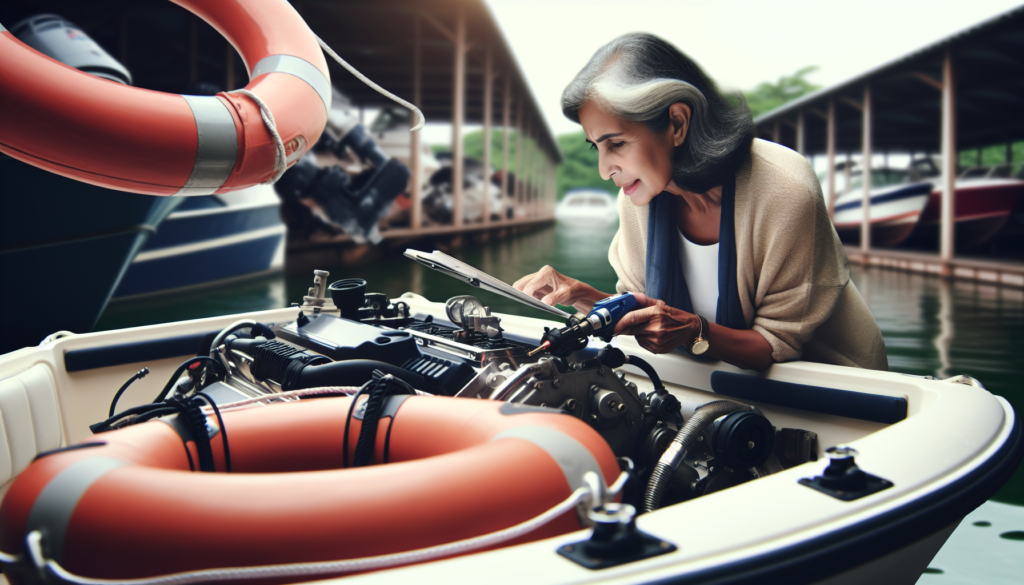Imagine navigating the calm waters, feeling the sun on your skin, and listening to the pleasant lapping of waves against the hull of your boat. Yet, this dream could turn into a nightmare if proper safety inspections were not done on your used boat prior to purchase. “Buying A Used Boat: Safety Inspections To Consider” walks you through the vital checks required for a satisfying boating experience. It ensures your sea adventure remains a thrill, free of unpredictable surprises, and promotes a deeper understanding of what to look for in your potential marine companion.

The Importance of Boat Safety Inspections
Navigating through the exhilarating waters in your own boat engenders a sense of freedom and adventure. But a day on the water could quickly evolve into a distressing situation if your vessel were to encounter an unexpected issue. The key to reducing such chances, lies in a simple, yet crucial step – boat safety inspections.
Understanding the need for safety inspections
Boat safety inspections involve a comprehensive evaluation of each component of your boat, from its mechanical system to structural integrity. They ensure that certain safety standards are met and potential issues are accounted for. Regular inspections help maintain your boat in optimal condition, detecting problems that are not immediately noticeable but could potentially affect the performance and safety of your boat.
Potential risks of skipping safety inspections
By skipping boat safety inspections, you risk encountering unanticipated mechanical failures, broken equipment, structural weaknesses, and more. Such issues can lead to accidents, causing harm not only to your vessel but potentially, to you and your passengers as well.
Legal implications of boat safety inspections
Boat safety inspections are not just about maintaining your boat in a seaworthy condition; there are legal implications associated with them too. Many jurisdictions require boats to pass safety inspections in order to be considered legal for operation. Failing to comply could result in fines, or worse, legal prosecution.
Understanding Boat Types And Their Inspection Needs
There is an array of boat types, each with its unique set of inspection requirements. Understanding these requirements is essential to ensure the safety and optimal performance of your vessel.
Differentiating between boat types
From kayaks and sailboats to power boats and large yachts, boat types vary vastly. Each type is designed for different water conditions, speeds, and usage, and hence, they need to be inspected differently.
Specific inspections required for different boat types
For instance, inspection of a sailboat may require a thorough examination of its sails, rigging, and mast which wouldn’t be necessary for a powerboat. Powerboats, on the other hand, may need more emphasis on engine and propulsion system inspections.
Understanding the construction and mechanics of a boat
An essential part of ensuring a successful inspection involves understanding the boat’s construction and mechanics. This enables you to discern the areas that are more susceptible to wear and tear. It gives you a clearer perspective on what to look out for – possible weak points, signs of damage or neglect, and the nuances of your boat’s particular make and model.

Inspecting Boat Hull and Structure
The hull and structure of your boat are the foundation of its safety and performance; any weakness in these could compromise the rest of your boat’s operations.
Understanding the significance of a boat’s hull and structure
The hull of a boat serves as its primary protective barrier against the punishing waters. Any weaknesses in the hull or structure can result in leaks or in worst-case scenario, complete failure.
Look for signs of structural damage
Inspection of the boat’s hull and structure involves looking for signs of damage such as cracks, blisters, or delamination.
Evaluating the hull condition for water leakage
You should also evaluate the condition of the hull for any water leakage. Check the deck, also, for any soft spots as these could indicate rotting below the surface or other structural issues.
Assessing The Boat’s Mechanical Condition
A key aspect to consider during a boat inspection is its mechanical condition. This ensures that the boat runs smoothly and is safe to operate.
Inspecting the boat’s engine
The engine, being the heart of the boat, should be subjected to a comprehensive inspection. Check for any leaks or unusual noises, the oil condition and level, and also review the cooling and fuel systems.
Checking for mechanical reliability
Mechanical reliability can be evaluated by examining the boat’s steering system, cables, gearbox, and the prop shaft. Check for any unusual wear and tear, corrosion, or misalignment.
Understanding the boat’s past maintenance history
Knowledge of the boat’s past maintenance history can provide insights on how well it has been cared for. Always request for maintenance records and review them carefully.

Electrical System Inspections
The electrical system of a boat is often overlooked during an inspection, but it can significantly impact the boat’s operation.
Prioritizing the boat’s electrical system
Prioritising the inspection of your boat’s electrical system can help you detect any potential hazards, ensuring an overall safe boating experience.
Assessing the condition of the boat’s wiring
The boat’s electrical wiring should be inspected for any signs of corrosion, damage, or overly aged components. This includes checking the condition of connections, switches, and breakers.
Inspecting the boat’s electrical components for faults
All electrical components should also be inspected for faults. This includes navigation and radio equipment, lighting systems, and all charging and battery systems.
Safety Equipment Checks
Safety equipment checks are paramount for any boat inspection, as these are the features that could potentially save lives.
Identifying required safety equipment
Your boat should be equipped with appropriate safety equipment, including personal flotation devices, fire extinguishers, signal flares, sound-producing devices, and navigation lights.
Assessing the condition of safety equipment
Review the condition of each piece of safety gear, ensuring it is in good working order, easy to access, and meets the current regulations.
Understanding regulatory requirements for safety equipment
Regulations related to safety equipment can vary based on boat type, size, and areas of operation. Familiarising yourself with these regulations can ensure you are adequately equipped in terms of both legality and safety.

The Boat’s Propulsion System
Inspecting the propulsion system of a boat can give you a good idea about its performance and efficiency.
Examining the boat’s propellers and propulsion system
Do a thorough check of the boat’s propellers for any signs of damage such as dings, pitting, or cracks. Inspect the boat’s propulsion system, including the shaft, struts, and cutlass bearing for any wear or corrosion.
Understanding common issues with propulsion systems
Understanding common issues with propulsion systems, such as vibration, overheating, or reduced efficiency can provide a basis for what to look for during the inspection.
Estimating cost for repairing or replacing propulsion components
Assessing the possibility of having to repair or replace propulsion components can be crucial as these costs can add up quickly. Be aware of such costs before finalising your purchase.
Understanding Marine Surveying
A marine survey provides a comprehensive evaluation of the boat’s condition and is usually recommended when purchasing a used boat.
The role of a marine survey in boat purchasing
A marine surveyor’s report serves as a validated document outlining the overall condition, safety, and valuation of the boat. It is crucial for evaluating the boat’s seaworthiness and can often be required by insurance companies.
Identifying reputable marine surveying services
Finding a reputable marine surveyor is key to ensuring accuracy in the inspection results. They should be certified by recognised governing bodies like the National Association of Marine Surveyors or the Society of Accredited Marine Surveyors.
Acting on a marine survey report’s findings
After receiving the marine survey report, you should take time to study it carefully. It can give insights on whether the boat is worth purchasing, what repairs are needed, and how to negotiate the purchasing price.
Insurance implications of safety inspections
Insurance companies heavily weigh the results of safety inspections when making decisions about coverage and premiums.
Understanding the correlation between safety inspections and insurance coverage
Insurance companies see safety inspections as a measure of risk. A well-maintained, safe, and sturdy boat is less likely to incur damages, making it a lower risk for insurers.
Determining required inspections for insurance approval
Different insurance companies may require varying levels of inspection. It’s important to determine what your insurance company specifically requires to ensure you meet their standards.
Consequences of inadequate or failed inspections for insurance
Inadequate inspections or those that reveal significant issues can lead to higher premiums or refusal of coverage altogether. Regular inspections can help you avoid these scenarios by identifying and rectifying problems early on.
After the Inspection: Finalizing Your Purchase
After performing a thorough safety inspection, you can make an informed decision about purchasing the boat.
Deciding based on the results of the safety inspection
The results of the safety inspection play a pivotal role in your purchasing decision. They can help you negotiate a fair price and guide your plans for the boat’s future maintenance and repairs.
Negotiating with the seller post-inspection
The findings from the inspection can be used as a bargaining tool to negotiate the selling price with the seller. You can argue for a price reduction based on repairs needed or compliance with safety standards.
Arranging the necessary documentation and finalizing your purchase
Once you have settled on the price, you need to arrange the necessary documentation, such as title transferal and registration. After finalizing these details, you can proceed with finishing the purchase and starting your new journey as a proud boat owner.
In conclusion, boat safety inspections are indispensable for ensuring the seaworthiness of your boat and your overall safety on the water. So, before you set sail on your next adventure, ensure that your boat is up to the mark, fully inspected, and ready to face the open waves.

